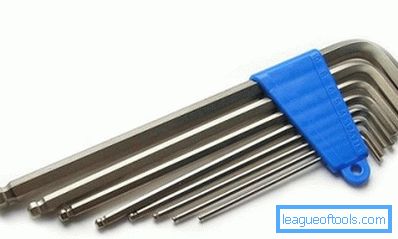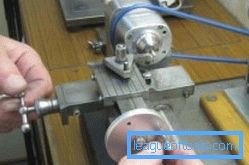How to make a hexagon
Currently, the hexagon is one of the most indispensable tools in the process of carrying out these or other repair work. Many modern bolts are equipped with heads of this type, so they simply can not be unscrewed with an ordinary open-end wrench. Not every person has a hexagon at home. If it is urgently needed, the question arises, and how to unscrew the bolt if the tool is not available. You can use various tools available instead of a hexagon, but this is not always convenient. It is better to go a little different way. How to make a hexagon independently, will be discussed further.

Hexagons are used to loosen and tighten the bolts during the repair and assembly of furniture.
Tools and materials
Yes, the hexagon is a rather difficult tool to implement. It has the correct, but not quite standard form, so making it is not so easy. In most cases it is much easier to go to the nearest store where the tool is sold. This tool is not so expensive to save on it. However, if the tool is needed urgently, and it is already night outside, then in most cases it will not be possible to purchase the tool. You have to do it yourself. For work you will need the following:

Drawing hexagon in a circle.
- measuring tool, without it in this case nowhere, because you have to get the correct hexagonal shape, and this is not so easy;
- metal bar from steel 45;
- incisors;
- Sander;
- sandpaper.
Basically, this is quite enough to carry out the whole complex of works.
Back to table of contentsPreliminary preparation
First, it is imperative that you carefully prepare for the further conduct of the entire range of activities. First you need to prepare all the necessary tools. It is also necessary to select the bar as high as possible so that it is able to withstand the load that the hexagon takes upon itself during operation.
So, the workplace should be all the most necessary incisors. Of course, one cannot do without a lathe here. Work to be thin, so the cutters should choose the highest quality. Now it is necessary to prepare a stencil that will produce markings on the side face of the hexagon. After all, it is necessary to make a full-fledged tool from a shaft of circular section. To remove excess iron filings you will need a brush. This is all the preparatory work that must be carried out before further work will be done.
Back to table of contentsTurning: process features

A hexagon is turned from a steel bar on the grinding machine.
The first main stage of work will be turning from the existing rod of a shaft of a certain section. It must correspond to the size of the hexagon, which is necessary in this particular situation. Vernier caliper will be used for measurements. This is a fairly accurate tool with which you can easily make all the most necessary measurements. So, the workpiece is installed in the lathe. It should be mounted on both sides with the help of special holders. By the way, it is worth noting that it is not possible to make a small hexagon by this method. Only an impressive size tool can turn out.
From the back side, the future hexagon is pressed by the headstock. Now everything is set strictly horizontally, which means that you can safely proceed to processing. It may just be rough, and you can bring the tool to shine. It does not matter, because later still have to do face.
So, the machine is running, which means that it remains only to control all the necessary dimensions. The output should be a bar that has a diameter equal to the size of the hexagon. This is done very simply. Most importantly, do not forget to constantly make measurements using calipers. Only in this way you can get a really correct figure at the exit. After the work is fully completed, we can state the fact that the pre-workpiece is ready for further processing. It will be made already with the help of a vice and a grinding machine.
Back to table of contents
Getting Faces: Recommendations

All sizes can be measured with a caliper.
So, turning operations are completed, and this means that you can go on to get the edges. To do this, do not rely solely on their skills. First you need to make a stencil on paper, which will fully correspond in its geometrical parameters to what you want to get at the exit. Then it is circled on the already finished shaft. So, all the measurements have been made, which means that the part can be safely clamped in a vice. It is completely ready for processing. In a vice it is clamped in a horizontal position.
For grinding, you can use a rough circle, as you have to remove several layers of metal.
It is very important to do all the work as competently and accurately as possible. Once the work is completed, you can check the edge for compliance with the size. This is also done using a measuring tool. In this case, you can handle a conventional caliper. If the size does not match the declared values, then it is necessary to fit it to them. This is done by post processing.

Hexed sandpaper polished.
Now you can flip the future hex with the other side, continue to sharpen the edges. Approximately for this you will need about half an hour. After that, you can check the entire device for compliance with the required geometrical parameters. If everything is OK, then the result is worth fixing. For subsequent sanding, you can use ordinary sandpaper. Be sure to remove all burrs and excess metal. After this is done, you can proceed to further work. It is to check the performance of the tool. You just need to install the hex in the desired bolt and try to unscrew it. If everything was done in strict accordance with the technology, then it should be twisted without any problems.
Of course, the resulting construction has several drawbacks. The most important of these may be the wrong shape of the tool. It is obtained strictly straight without any bends. If we talk about the standard hexagon, then it is made at an angle of 90 degrees for ease of operation. Of course, this drawback does not prevent the loosening of the necessary bolts. The resulting tool can be additionally equipped with a handle or simply use pliers to loosen the mounting bolts.
Thus, now you know exactly how to make a hex with an improvised tool. As you know, this process is quite complicated, but it is quite possible to implement it, especially without straining. The main thing is to have at your disposal all the most necessary tools. Of course, without the skills of working with turning tools and machines simply can not do. The grinder must also be operated correctly. Otherwise it will be hard enough to get the necessary tool with the specified quality characteristics at the output. That's all for its logical conclusion. It is hoped that the resulting tool will serve you for many years.